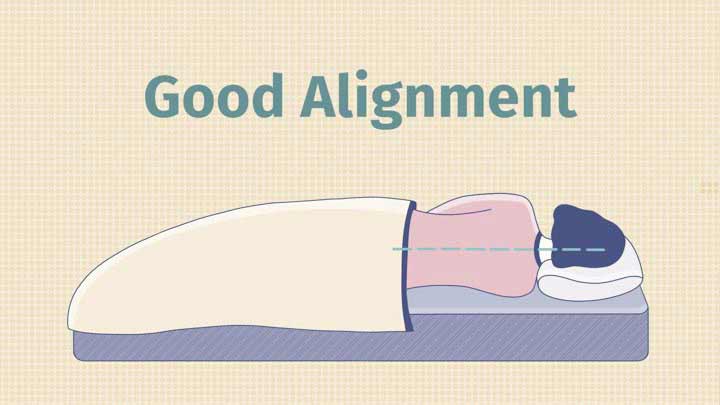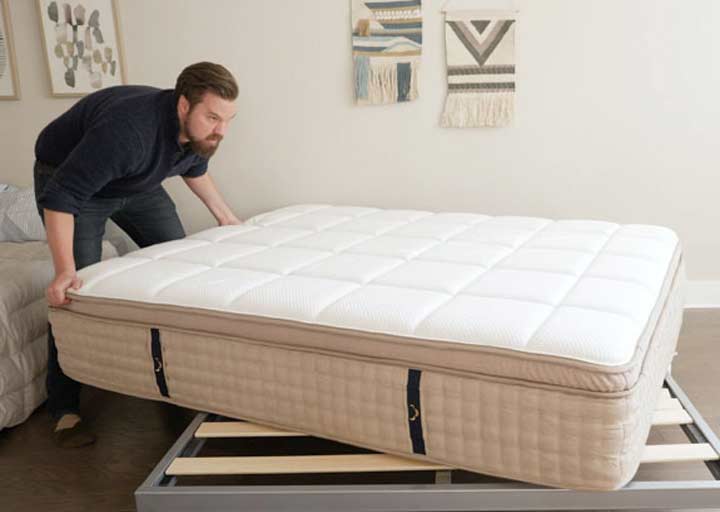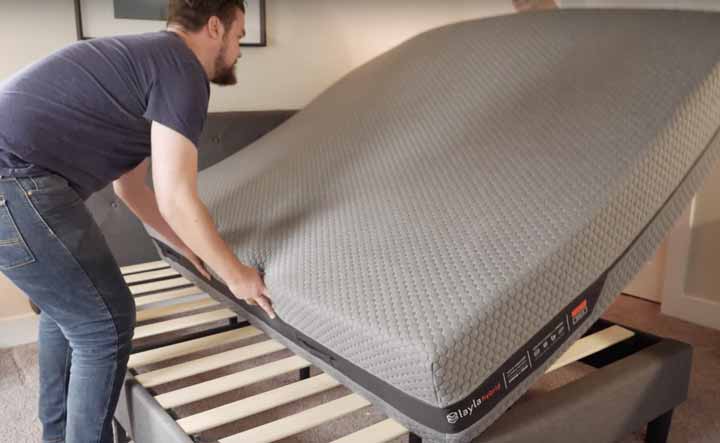If you’re like me, you grew up rotating or flipping your mattress over every now and then — always after a gentle reminder from Mom, of course.
We’ve been told (correctly) that rotating and/or flipping your mattress is often the key to its healthy performance and long lifespan. When we sleep in the same spot every night, our body weight leaves an impression in that spot. If we do not rotate our mattress and give that space the ability to recover, we may need a new mattress sooner rather than later.
Now, with a new generation of bed in a box mattresses made with specific and customized layers, rotating and flipping may no longer be necessary. That being said, we’ve put together a general guide to rotating and flipping a mattress to help address the following questions:
- Why should I rotate my mattress?
- Does my mattress need to be rotated or flipped?
- How do I do it?
- How often should you rotate your mattress?
Keep in mind that more likely than not, the folks who make the mattress will tell people whether or not it needs to be rotated or flipped. To keep your mattress warranty in good standing, we’re going to suggest that people go with the manufacturer’s recommendation above everything else.
RELATED: Best Flippable Mattresses
Why Should I Rotate My Mattress?
First, let’s clarify what we mean by “rotate.” When we talk about rotating a mattress, we mean moving the mattress 180 degrees, so the portion that was at the head of the bed is now at the foot of the bed.
As we mentioned up at the top, some mattresses needed to be rotated because it evens out the overall wear and prolongs the bed’s lifespan. It also helps keep the spine in neutral alignment, a crucial aspect of getting a good night’s sleep and waking up pain-free.

Sleeping in the same spot every night, night after night will cause the bed to wear unevenly over time. This can also result in sagging, which will cause the spine to get out of alignment and could ultimately cause people to feel pain and potentially need to replace their mattress. By rotating it, people are giving one area a chance to recover and a fresher spot to take on new weight.
Rotating your mattress is one of the best ways to make your mattress last longer. Also, see our list of the best mattresses that won’t sag.
In addition, if your mattress cannot be saved, check out our piece on mattress disposal.
How Often Should I Rotate My Mattress?
There are so many different materials and combinations of materials used in mattress construction now that there is no one-size-fits-all answer to how often people should rotate their mattress.
In general, mattress brands that recommend rotation suggest doing it every three months to once a year. The main point seems to be that people keep up with it and try to be regular about their rotations.
How Do I Rotate My Mattress?
Here are some recommendations on how to rotate a mattress in the most stress and hopefully pain-free way possible.
1. Plan out rotations for the year in advance
People should use a phone, laptop or a printed calendar to remind themselves to periodically rotate their mattresses through the year. Some mattress brands may recommend every three months, in which case they could use the beginning/end of a business quarter to rotate. The Fourth of July holiday is a great halfway point to rotate the bed as well. And it’s never a bad idea to start the new year out sleeping on a fresh side of the bed, either.
2. Prep the space
Nothing is more frustrating than lifting a heavy mattress and holding it while people make decisions. People should spare themselves by moving nightstands away from the bed, removing all bedding and deciding if to turn the bed clockwise or counterclockwise first.

3. Strategize the rotation based on the bed
If people have a bed with a headboard, they will want to move the mattress slightly away from the top of the bed before rotating. If it also has a footboard people could lift the mattress and rest it on the footboard to aid in their rotation.
4. Get in there with the vacuum, while possible
Depending on the mattress and bed set up, it may be worth pausing mid-rotation to grab the dustbuster and get into those hard to reach spots under and around the bed and mattress. Adding fresh clean sheets to the newly rotated bed may make people feel like they’ve got a brand new bed.
What Mattresses Need To Be Rotated?
Unless the mattress company that someone purchases their bed from says otherwise, it’s almost always a good idea to rotate the mattress regularly.
Here is a list of mattress types that would benefit from rotation:
- Memory Foam
- Latex Foam
- Innerspring
- Hybrid (a mix of more than one material – usually a combo of foam and innerspring)
In some cases, air beds with foam toppers will also benefit from rotation.
Some mattresses should not be rotated because they are only supposed to be facing one direction. For instance, the Level Sleep mattress features a proprietary zoned construction, and the lumbar zone will not be in the right position if the mattress is rotated.
Why Should I Flip My Mattress?
The truth is that most modern mattresses are not meant to be flipped. For the most part, they are designed with specific layers and will not operate correctly if turned upside down. Typically, only older and innerspring mattresses that aren’t pillow-top mattresses should be flipped.
The steel coil springs inside an innerspring mattress will wear out over time if someone sleeps in the same spot on the same side every night for the entire time they own their mattress. To help remedy this, it is recommended that people not only flip their innerspring mattresses over but rotate them as well.
Take a look at our list of the best innerspring mattresses for information.

How Do I Flip My Mattress?
It is a good idea to rotate a mattress when flipping it, as it will help with even wear and increase longevity for all mattresses. Check out our tips for rotating a mattress earlier in the post.
During the rotation process, take the opportunity to flip the mattress upside down and continue rotating until it’s completed its 180-degree turn. This may be possible to do on one’s own, but for larger or heavier mattresses it may be best to have a friend to help.
Non-pillow top innerspring mattresses tend to be the type of mattress that will still need to be flipped, but foam mattresses that are designed with specific layers do not need to be flipped. If people have a hybrid mattress with springs or a traditional innerspring mattress, it would be wise to consult with their mattress manufacturer before rotating or flipping.
Final Thoughts
Keeping all this in mind, it should be easy for most people to rotate and flip their mattresses. Again, make sure to ask a friend for help because there’s no need to make it harder than it is!
FAQs
Is it good to rotate your mattress?
It is a very good idea to rotate a mattress because it will even out the wear and indentations that form over time. Rotating the mattress every 3-6 months should ensure that it will last for a longer amount of time.
Do you need to rotate a hybrid mattress?
Most hybrid mattresses need to be rotated so that they wear evenly over time. Just make sure to check with the manufacturer about when is the best time to rotate.
Can you flip a one-side mattress?
No, one cannot flip a one-sided mattress. A one-sided mattress is built to lie one way, with the support layer on the bottom, the transition layer in the middle, and the comfort layer on top. Flipping the mattress will make it very uncomfortable to sleep on.
When should I rotate my mattress?
It depends on the mattress, but most companies recommend rotating a mattress every 3-6 months.

